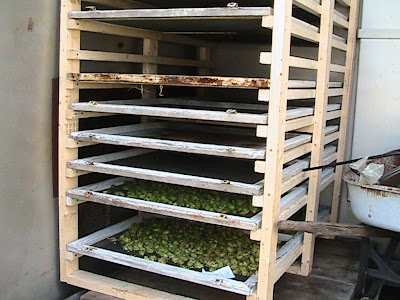Zulu
Well-Known Member
3 days on the drying racks, no forced air at this stage
















![Craft A Brew - Safale S-04 Dry Yeast - Fermentis - English Ale Dry Yeast - For English and American Ales and Hard Apple Ciders - Ingredients for Home Brewing - Beer Making Supplies - [1 Pack]](https://m.media-amazon.com/images/I/41fVGNh6JfL._SL500_.jpg)
Other tips you can utilize...
- Use a space heater to help raise your temps into the 100-130 degree range. (works great if you live in a hot climate with a garage that isn't well insulated!)
- flip the filters so the side nearest the fan doesn't overdry relative to the opposite end
BTW, this is essentially Alton Brown's method for herb drying applied to hops.

 :
:GVH_Dan said:This is a copy from a post I put in a different thread, but relevant to the question you just asked.
It is possible to overdry hops but not easy unless you are using heat or in a desert. When they overdry, the bracts will fall off and the lupulin will fall out. If you are using heat, you may also dry out all the oils and aromas, leaving you with tasteless stigs.
Basically, every non living thing absorbs and desorbs moisture from the air at a rate that is controlled by the relative humidity of the air. For every Equilibrium Relative Humidity (of the air) there is a corresponding Equilibrium Moisture Content (of the hops in this case). If the Relative Humidity goes up, the item absorbs more moisture until it comes back to equilibrium. This is true for hops.
If you check my pictures, I believe I have an isothrem for hops posted. It basically shows that you can dry to less than 15% moisture content regardless of the air conditions. Assuming you are going to freeze them or use them right away, that is probably sufficient. If you are a commercial grower, you want to get to 8 to 10% moisture content, which means 50% RH or less. "Too dry" is somewhere less than 5%.
To hit 5%, you need very dry air for a long time. Or, you put it in a space that is really warm, which lowers the relative humidity, and poof...you have a pile of bracts and yellow dust. In that case, I just saw a thread where someone used the lupulin as a rub on his spare ribs. You can try that.